
Comments From BlueSky Software
- BlueSky Software was founded in 1988 to create Atari 7800 games, and in its time has produced a large number of successful Genesis titles, including: Jurassic Park, Looney Tunes: Desert Demolition, Shadowrun, World Series Baseball, College Football's National Championship, and NFL Sports Talk Football '94.
- BlueSky this year also signed agreements to work with Data East on several games (a number of baseball and football titles which have been scheduled in the next few years for the Sony PlayStation and Sega Saturn), and with WarnerActive who will provide marketing/promotional support as well as technical support for a number of upcoming action-adventure titles (the first two titles are currently slated for mid-1996 release).
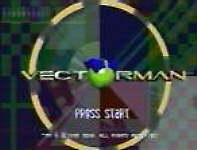
- Their latest endeavor, VectorMan, is due for release on October 24, 1995, and not only looks to be their best work to date, but possibly one of the best platform games to come out this year.
- We asked Rich Karpp, Lead Programmer on this title, what VectorMan is and where it came from. As well, what makes this game stand out above others like it.
- Rich replied, "VectorMan is not a man at all. In fact, he's an orbot." (robot + body made of orbs = ORBOT). "As the story goes, VectorMan is a member of a task force sent by humans to clean up the planet Earth."
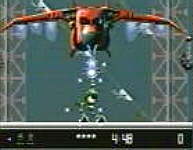
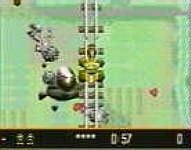
- "Basically, the vector-piece technology was going to be used for another game we were working on. It's based on some older (Amiga) computer demos that used spheres to plot the vertices of polygons. That was done because of limited processing power. It stands out from other games mostly because of the fluidity of the animation. Using vector pieces, we can interpolate between two frames of animation, so we can get animation to run as fast as the TV runs -- 60 frames per second. Another thing that helps the game is some terrific background art with a few cool effects that haven't really been used before."
- "Yet another aspect of our game that makes it stand out is the playability, I think. The fact that the animation runs so fast allows the game to respond to controls very quickly. So you don't get any delay between the time you hit a button and the animation response. Plus, we designed everything so there was minimum delay: there is no "wind-up" animation for shooting. That "wind-up" would take time between the button-press and the response, and I didn't want that to happen. A "wind-up" might have made the game seem more cinematic or realistic, but it would've sacrificed some playability."
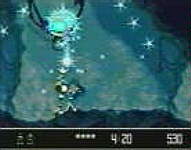
- BlueSky also provided us with some comments from Rich Karpp, and Marty Davis (one of the animators for the game). Here they make some comments about the character VectorMan and the animation behind the game:
- Marty: "Back in the early animation stage, the desire to use the tech look of quasi-3D animation with the game engine calculating in-betweens kind of drove the whole thing, pushing us away from doing the typical bitmap style animation."
- "Originally the game concept was an "all ball" kind of game as far as character appearance was concerned. It was going to be VectorMan, the enemies -- they were all made up of spheres -- all their pieces were spherical. And those pieces were just little bitmaps that remained constant, but their coordinates could be moved in a program that Karl Robillard wrote for us called the VectorMan Animation Tool. This tool allowed you to set priority on the pieces in relation to each other by using a Z axis coordinate; you could also move them around on the X and Y axis as well, allowing for full animation. Set in-between your extremes you can allocate "in-betweens" in powers of two, which the game engine will then calculate. That way you can maybe do a walk with 12 extreme states of animation that the animator has created, but they're in-betweened by the machine to give you a 40-state walk. It's much smoother, much richer. It's linear in-betweening, so it's not like if you had a traditional lead animator creating extremes and an "in-betweening animator" filling in the gaps between states where they arc all the motion paths and put the follow-through in and time the action to slow-in and speed out, etc. Everything has to be really linear. With the VectorMan Animation Tool we're able to get in maybe 10 times as many states as we used to have with traditional bitmaps. There's really almost no limit to the animations we can have since those files don't take up much room."
- "Along the way we've identified that people wanted more recognizable elements, something more than characters made up completely out of balls, so we started adding more specifically recognizable elements, such as VectorMan's hands."
- Rich: "First he (VectorMan) was all balls because we were having different levels where you'd be playing at different scales and possibly different angles. So all of it would be algorithmically changed so you're looking at things from different angles and you can only do that with balls. But as it progressed to be more of a regular platform we went for more of a human character and added the hands and feet."
- Marty: "Yeah. He's a good in-between, between the all balls 3-D possibility and the 2-D bit map. And the enemies were all balls to begin with. But balls are, essentially, a friendly shape so the enemies created out of nothing but spherical shapes didn't look very threatening. As we progressed, we tried to play up the dangerous elements of the enemies and their appearance has changed accordingly. They have a lot more parts now, and the parts themselves can animate. ...and the game samples at 60 frames a second, which is twice as much as video and like 2 1/2 times as much as film. As far as animation you usually do everything on two's so you only get 12 frames a second, so that's five times more. It's a big improvement and it looks incredibly smooth on the screen."
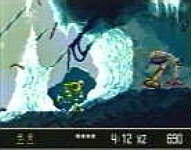
- We also gathered comments from Karl Robillard (who coded some of the internal development software) and Jon Holland (VectorMan's music/sound composer):
- When asked about the type of environment (OS, etc...) VectorMan was developed under, in general Karl mentioned that they used "Cross Products SNASM68k on the PC and some custom software on the Amiga to do the tweening."
- Jon, when asked to describe VectorMan's soundtrack: "Music filled with gun noises! Just kidding. I would describe it as rhythmic. That is what I was striving for. I tried to get close to a dance feel much of the time, but it's especially difficult to get good techno sounds with FM on the Genesis. I used GEMS on the PC for the sound editing. It's a rather primitive program. Maybe one day game sound chips will have TR909 and TB303 sound emulators built-in!"
- ...when asked what the worst thing about creating the soundtrack was: "Definitely the limitations of the sound hardware. Trying to make interesting music with the Genesis is like trying to write a concerto on a ukulele."
- ...when asked if he is looking forward to developing on next generation CD-ROM systems: "Yes, very much so. First of all, the sound hardware is quite powerful, but more importantly, doing digital audio is going to change game music drastically. Even if a project does not allow a composer always to take full advantage of the Red Book CD audio because of storage and graphics data streaming, there are still digital audio wave file alternatives that are better than MIDI files. I would much rather have 16bit/22khz playback of digital audio recorded in a studio than MIDI files playing a sound chip, even a great sound chip."
- "I would probably be happier with mono digital audio than MIDI. I'm going to try to avoid the MIDI stuff as much as I can, but since I don't yet know the reality of developing for these systems, I can't predict what I will or will not be able to do. Maybe I'm dismissing the capabilities of these machines prematurely; I don't know. But I do know that at this time even the most powerful MIDI keyboard in my studio is not capable of outputting finished music sequences that are record quality, at least not by my standards. And I don't see how a chip on a game platform will be capable of this. I suppose I should watch what I say, because in six months I may have to eat my words. Technology does not like to be challenged. It has a way of winning every time."
-R.I.P.
(10/95)
[ New Contents ]
[ Classic Contents - Articles - Reviews - Comics - Codes ]






